
With each new team, a new start – otherwise called “Kick-off” for some. It is an important moment in the life of a project because if we compare it to the launch of a rocket, if the initial trajectory is not good, the chances of success are reduced! It is with this responsibility in mind that I set about designing a 2-day Kick-off for a team wishing to start in Kanban.
The context

You should know that before this famous Kick-off, 2 one-day Kanban training sessions were carried out. They mainly brought together people from IT, AMO and a representative from Business.
Here are the elements of context that I have at my disposal at this time – to which I associate my reflections:
- The team consists of approximately 30 people.
- It's a big group (for me anyway!) so I'll have to find workshops to work in small groups to stay efficient.
- Consequently, there will be a need to set aside time for restitution to the whole.
- Members are divided according to 3 trades : Business, AMO and IT
- Different professions therefore probable tensions at the level of the interfaces.
- Possible misunderstandings or misconceptions of what each does.
- Knowledge / understanding of the concepts of agility are not not homogeneous
- Alignment workshops – on the objectives for example – can be relevant so that everyone goes in the same direction.
- Be careful to remain vigilant to myths and misunderstandings on this subject.
- Members are scattered on 3 different sites: 2 in France and 1 abroad
- An international context therefore a need to build the Kick-off in English.
- It will be necessary to ensure that the messages are understood by all – even if it means having to translate into different languages if necessary/possible.
- Business seems to be detached of the Agile transformation process
- The workshops should highlight the importance of an end-to-end approach to show that everyone is involved and to increase the chances of success.
- The Kick-off dates have been decided and sent to us by the hierarchy without our consent prior
- Which implies that we do not have the information on the why and how of the transition to Team Agility and the choice of Kanban
- It is possible that this is the case within the team itself and therefore it may be relevant to synchronize everyone on this subject
- People from different divisions don't know each other obviously all very well
- We can focus on Team Building at first, this is the opportunity!
- THE schedule days are not homogeneous:
- D1 (10.00 – 17.30) and D2 (9.30 – 16.30) with the lunch break to manage
- Keep the objectives in mind to be able to chain the workshops in a coherent way
Operating rules
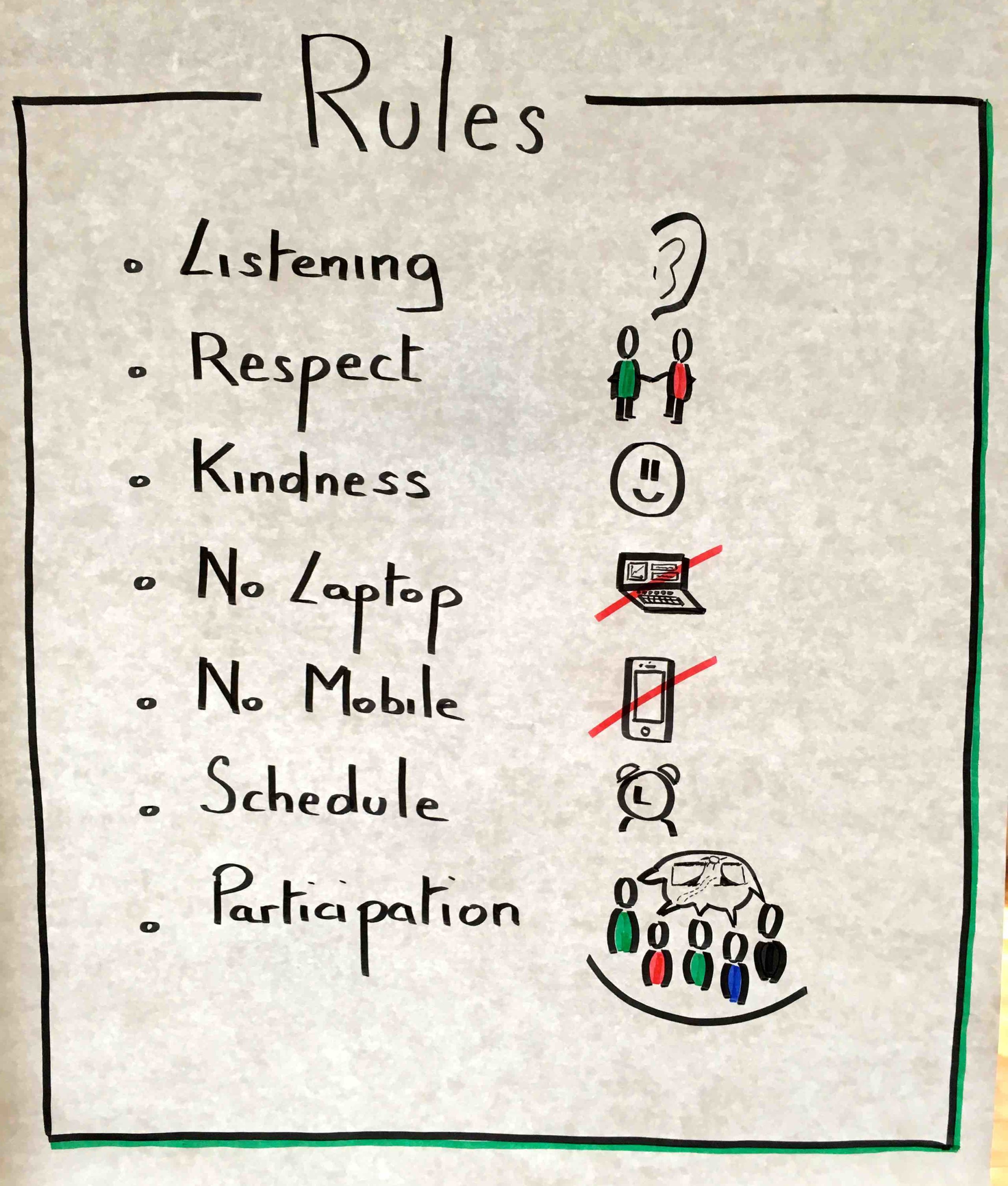
The operating rules are, in my opinion, a fundamental element of the framework for structuring an event of this type.
However, it is not enough just to display them somewhere in the room, it is necessary to take note with the group of the importance of respecting them to optimize the results. Let's not forget that as a facilitator, facilitator, coach, we guarantee the framework and not the content: the defined framework is then at the service of the participants to allow them to focus on the content.
Even if I am in favor of emergence and co-construction with the group, I think it is quite appropriate to impose these few elements at the start of the session, especially if we are short of time. In this case, I always make the effort to make the link with the objectives to be achieved to explain why and materialize a link of parity with the participants.
Indeed, the rules are applicable for everyone, including me and allow to counter-balance constraints of the type " No computer“, “ No laptop explaining that breaks are planned to allow them to check their emails, make phone calls, and that it is obvious that if there is an emergency, everyone is free to withdraw. The “Schedule” rule is a good example of parity: if everyone makes the effort to respect the schedules then the participants will arrive on time and the leader will try to finish on time.
The objective here is to set up a systemic give-give / win-win relationship.
The overall framework
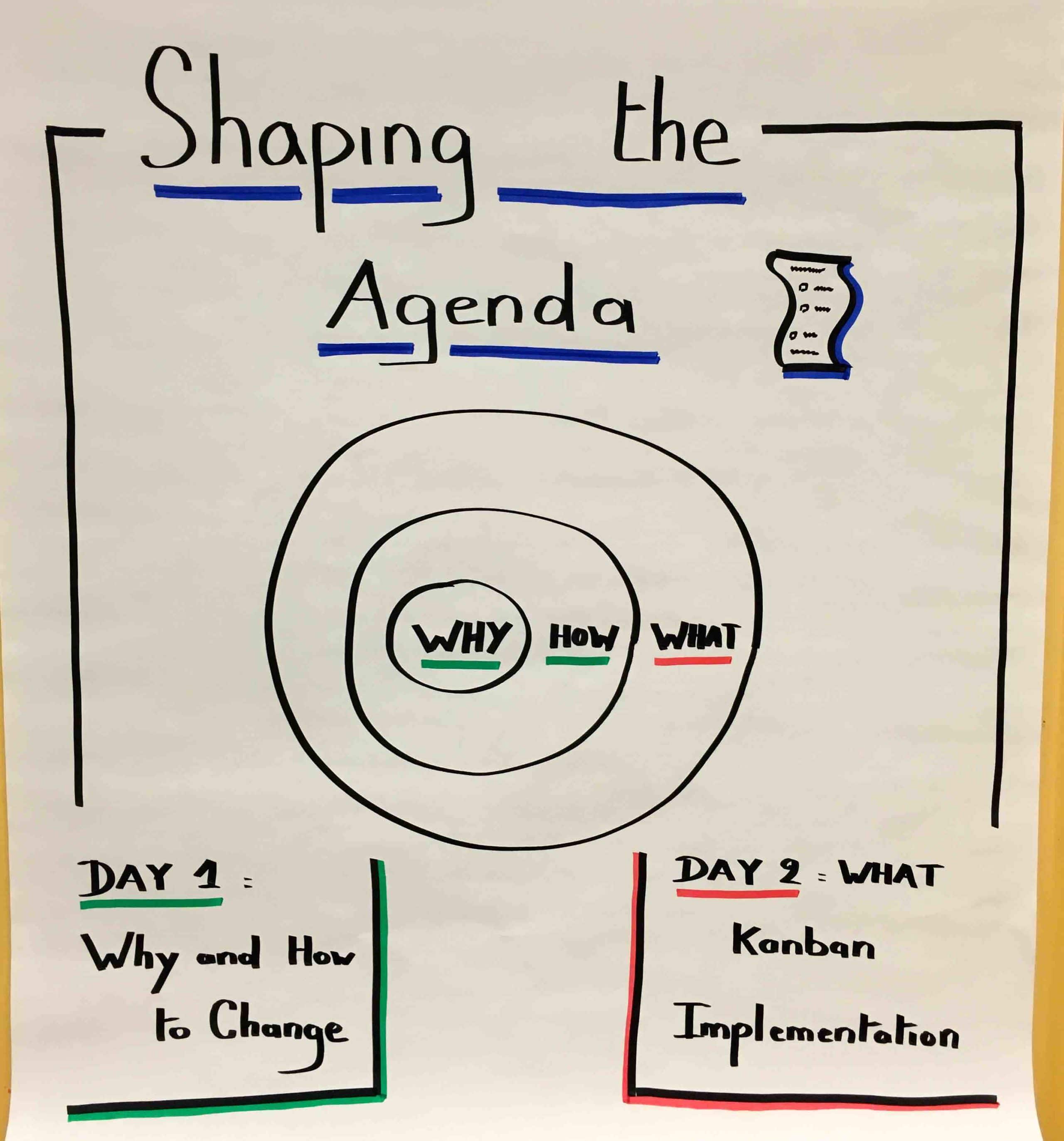
The golden circle
Since he was introduced to me by Christophe Keromen, I often use the "Golden Circle" model of Simon Sinek – author of “ Start with Why – to structure my mind. So I had the 3 elements Why, How and What to be distributed over 2 days.
I then took a step back on the fundamental need that a team must have when it engages in an Agile transformation whether with Scrum, Kanban or any other derived framework: it is change! 🙂
I then decided to build my first day around the following questions:
- Why change? (why)
- How do we allow ourselves to change? (How)
The second day was then naturally built around the implementation of the tool chosen by the team: Kanban.
After having determined the framework of my 2 days of Kick-off, I then had to think about a coherent common thread.
STATIC
Immersing more and more in the Kanban culture led by mike burrows, I thought it might be a good opportunity to experiment STATIC (Systems Thinking Approach To Implementing Kanban), a systemic approach to implementing Kanban that seemed to fit my needs perfectly.
Here are the basic steps:
- Understand the sources of dissatisfaction
- Analyze demand and capacity
- Modeling the flow – the “learning process”
- Learn about classes of service
- Design kanban systems
- Conclude
Going through the excellent "Kanban from the Inside" by Mike Burrows, I said to myself that in 2 days, we could not cover the whole process, so even if it means not doing everything, we might as well do what we can correctly. In this sense, I decided to leave the classes of services aside: as much to do less to do better, isn't it? 😉
Thus, the way of distributing the stages of STATIK over the 2 days seemed to me the most relevant was:
- Day 1: Why / How to change?
- Understanding the sources of dissatisfaction (STATIK 1.)
- Day 2: What to implement?
- Analyze demand and capacity (STATIK 2.)
- Modeling the flow – the “learning process” (STATIK 3.)
- Design kanban systems (STATIK 5.)
In summary
Day 1 has an orientation Team Building and Alignment.
Day 2 has an orientation Comprehension and Visualization of Kanban systems.
The framework of the 2 days
D1: Team Building
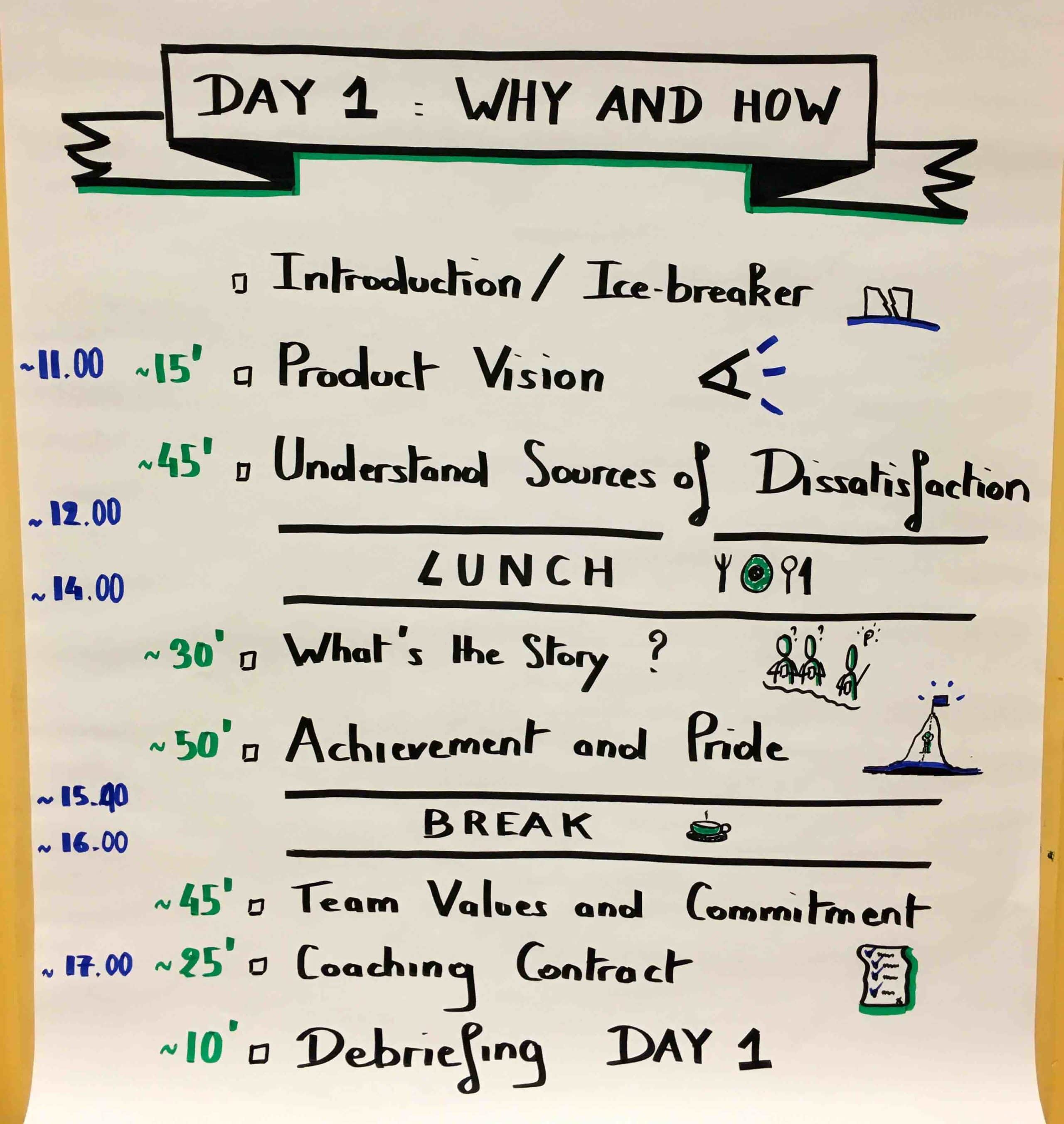
Day 1 being Team Building oriented, so I thought about how to make them interact together as much as possible by mixing specialties.
The Ice Breaker
I remembered an Ice-breaker used by Damien Thouvenin during a seminar that we had co-animated together which he had entitled: Diversity Scorecard – the diversity evaluation sheet.
The fundamental idea is to give a list of differentiating criteria to each person in the group. The objective is then to form groups with the most differentiating criteria: for each criterion, 1 point will be counted.
For example: I am a man, I work in IT, my mother tongue is French, I am under 30 years old and my number of years in the company is 1-3 years. I then count 5 points.
Workshops
The format of the workshops was mostly in the form of Consensus Workshop – from ToP (Technology of Participation) whose (simplified) process is as follows:
- The group is asked a question
- Everyone thinks individually and lists their ideas
- Everyone compares their ideas in sub-groups and selects a number of ideas (number defined by the facilitator)
- We share the ideas with all then we make groupings to be able to answer the question
Knowing that we would have:
- 4 varied groups thanks to the Ice Breaker,
- 3 Consensus Workshops in which I explicitly asked to vary the subgroups,
- 1 workshop of the Speed Boat type (which I have tried to animate somehow like a Hero's Journey)
- 1 energizer with the whole group
I was hoping to fulfill my purpose of sharing and group interaction! 🙂
The Energizer
I was looking for an activity to get people moving after lunch to get some fresh air and overcome this period of low energy. In order to stay in the theme of team alignment, I went on Zoom, an activity that I particularly like when we want to talk about subjects such as: global vision, self-organization, trust, interactions, communication…
But I won't tell you more here, I'll probably write a little more detailed article on the subject 🙂
D2: Kanban
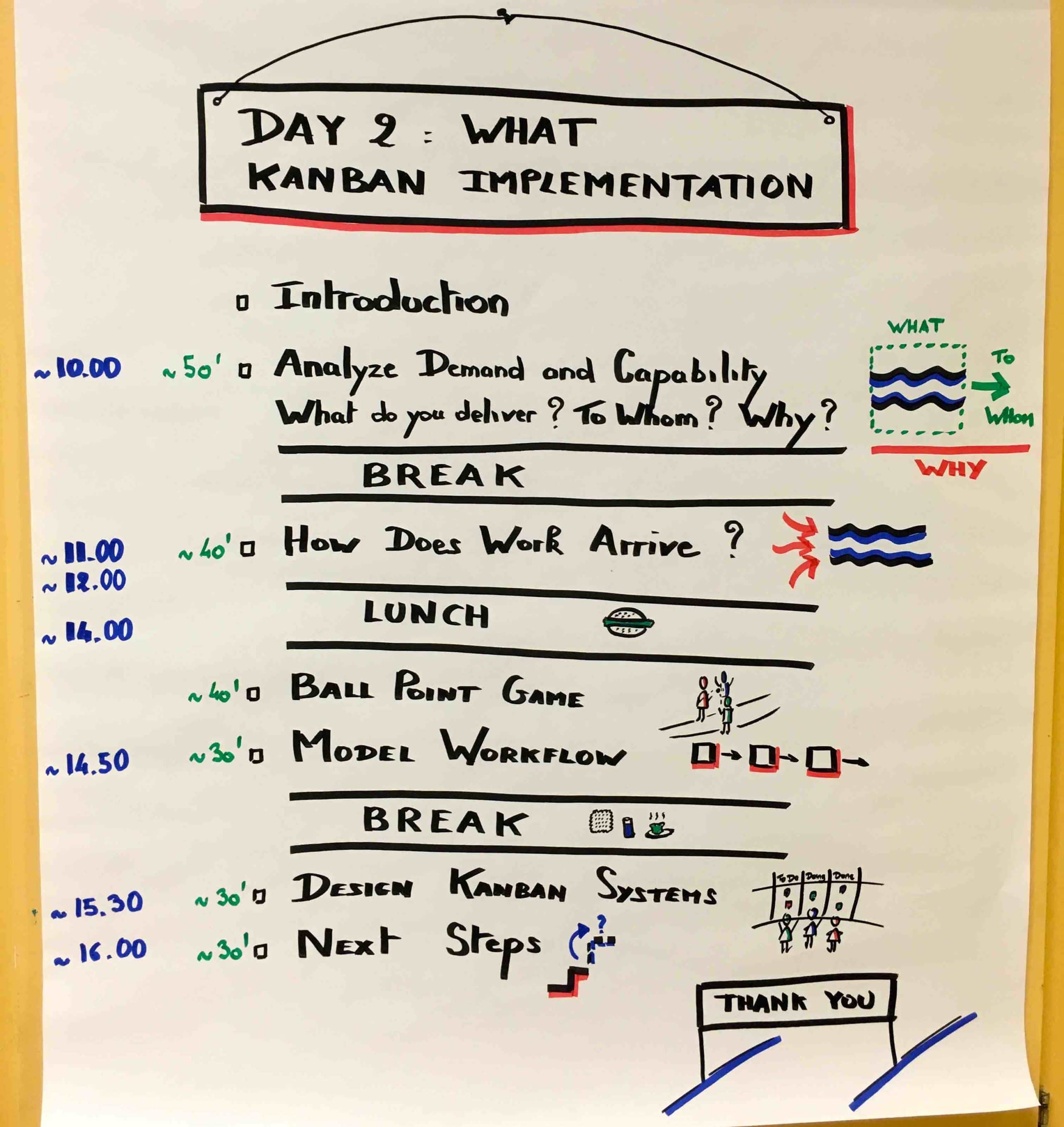
The second day focuses on the implementation of Kanban. As many speakers indicated during the Kanban conferences I attended in 2015, it is important to understand what you are doing before you want to change everything. Besides, isn't the Kanban approach the method that “starts with what you do”?
The day will therefore aim to help the team understand and share their current mode of operation to initiate the phase of incremental and evolutionary change.
The Ice Breaker
The common thread of the day being the system understanding (an essential value of Kanban), the choice of the Ice Breaker fell on the game of chairs to introduce different notions such as: respect, collaboration, agreement, leadership... and of course understanding! These elements correspond to the Kanban values introduced by Mike Burrows! 😉
The concept is simple: 3 teams, 3 different objectives… but complementary. Everything takes place in silence and we observe the behavior of the participants and the dynamics of the groups.
This activity will be led by Viviane Morelle who will be my buddy on this second day.
Workshops
We then continue the STATIK process started on D1 with the understanding of the sources of dissatisfaction.
- Initially, unlike the first day, the workshops will be carried out separately by Business, AMO and IT. The goal is for everyone to be able to share with others what they do, how they do it, why they do it… and thus ensure a collective awareness of everyone's job in the value chain.
- Secondly, they will model their flow, paying particular attention to the interfaces with the confrontation of Definition of Done “upstream” activities with Definition of Ready downstream activities.
- Thirdly, they will initiate their kanban systems using visual management tools.
The Energizer
As an after-lunch activity, my choice initially fell on the Ball Point Game, an activity used to introduce Scrum initially – in my understanding – but which also allowed to talk about the intrinsic velocity of systems which was mainly what I wanted to share.
I then became interested in Ball Flow Game, a variant adapted to Kanban brought by Karl Scotland (according to my research). The rules and constraints are the same, the variant is brought into the objective: instead of having to pass the maximum number of balls in 2 minutes (maximization of the value produced by timebox), we have a fixed number of balls (20 per example) that must be passed on as quickly as possible (maximization of the flow of the value stream). Give yourself 5 tries to experiment with different strategies.
Conclusion
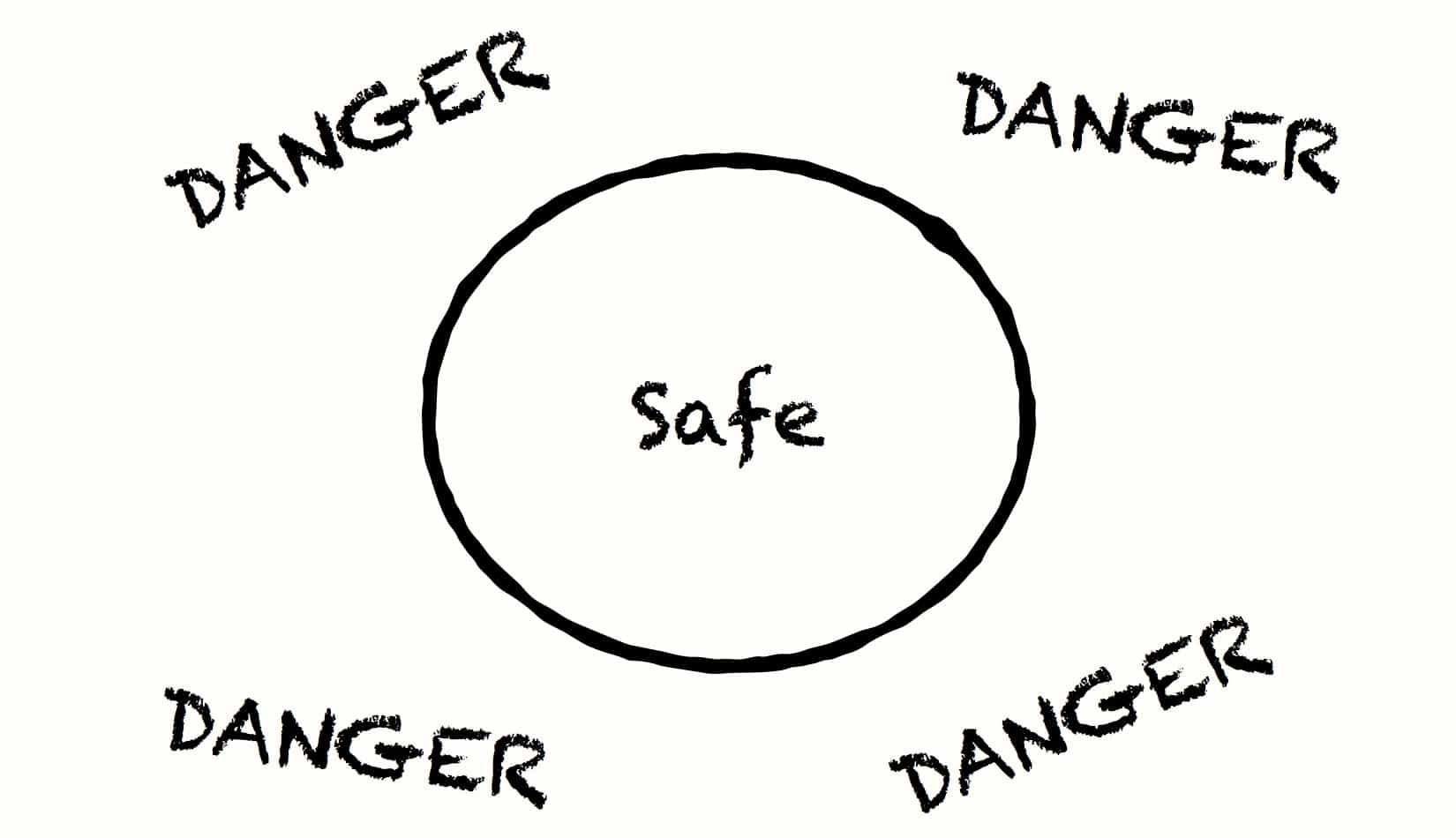
The framework is an element on which I pay a lot of attention today because in Agility we often speak of “self-organization” and it is a subject that remains difficult to deal with. Indeed, some people believe that self-organization is decreed and may confuse self-organization with self-direction.
It should not be forgotten that freedom exists today only within a framework. We can simply make the parallel with everyday life: we can feel free in our movements and our actions but we remain nonetheless subject to the laws which define the limits not to be exceeded. This is exactly what the frame should represent in my opinion, not a space that suffocates us but precisely a space in which we can experiment and flourish in complete safety while respecting the environment that surrounds us. This idea is described by Simon Sinek (him again!) in a conference entitled “ Leaders eat last – “ Leaders eat last” – where he describes the Circle of Security (see illustration).
Of course, these limits are not immutable but I think it is important to understand them before trying to change them.
The experience acquired through this Kick-off framing work was very instructive to me in the sense that it allowed me personally to better structure my thinking and to build for the team an environment favorable to creativity and the collaboration.






